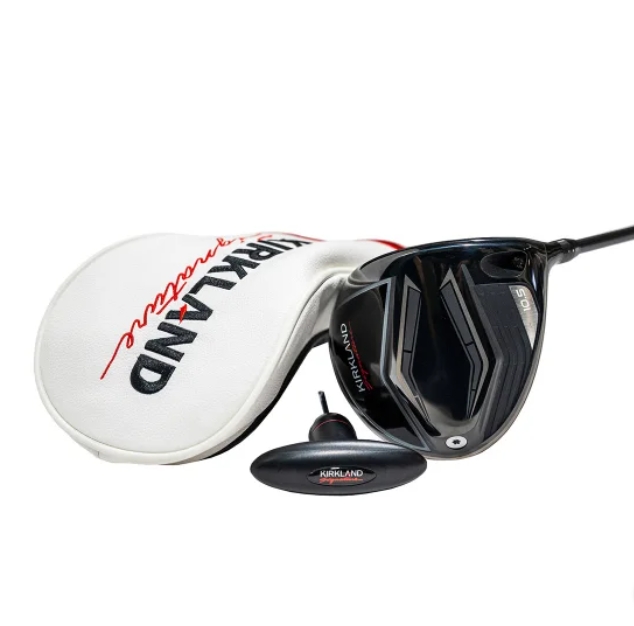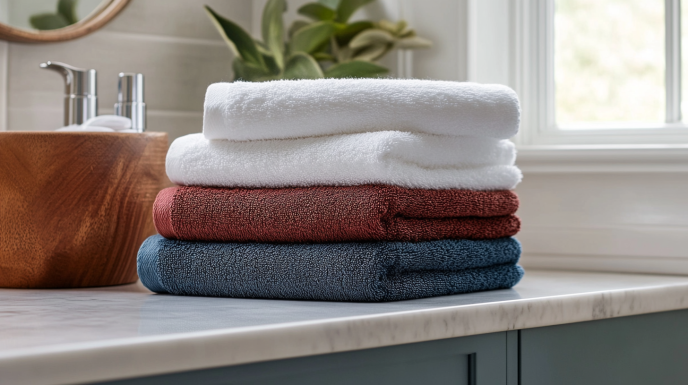
Kirkland Signature Adjustable Driver
- Right Handed
- True Temper EvenFlow Riptide Graphite Shaft
- Lamkin Crossline 360 Grip
- 10.5 Degree Loft with 4 Adjustable Hosel (Loft Settings: 9.5, 10.5, 10.5 Draw, 11.5)
- Kirkland Signature Headcover and Wrench included
How Costco’s Golf Club is Changing the Game for Average Players
In the world of golf equipment, brand names like TaylorMade, Callaway, and Titleist have long dominated the conversation. But in recent years, a surprising contender has entered the fairway: Kirkland Signature, Costco’s private label brand. While Kirkland has made waves with its golf balls, many golfers are now asking about the Kirkland driver. Is it real? Is it any good? And most importantly—is it worth your money?
As an avid golfer who’s tested dozens of clubs over the years, I’ve been fascinated by Costco’s entrance into the golf equipment space. What started with golf balls has expanded into a full line of clubs that has many weekend warriors reconsidering their allegiance to traditional golf brands. Today, I’m diving deep into everything you need to know about the Kirkland Signature driver—from specifications and performance to value and availability.
The Kirkland Driver: Fact or Fiction?
Let’s address the elephant in the room: Yes, Kirkland Signature does make a golf driver. After the tremendous success of their golf balls (which earned a cult-like following for matching premium ball performance at a fraction of the cost), Costco expanded their golf equipment line to include a driver, fairway woods, hybrids, irons, wedges, and putters.
The Kirkland Signature driver was introduced as part of Costco’s strategic move to offer complete golf club options to their members. Like other Kirkland products, the driver follows the brand’s philosophy of offering quality comparable to name brands but at significantly lower prices.
When the driver first appeared on Costco shelves, many golfers approached it with skepticism. After all, how could a retailer known for bulk toilet paper and rotisserie chickens produce a driver that could compete with golf industry giants who spend millions on R&D? Yet the Kirkland driver quickly gained attention not just for its price point, but for its legitimate performance characteristics that had many golfers doing double-takes during their first few swings.
Where to Find the Elusive Kirkland Driver
If you’re looking to get your hands on a Kirkland driver, there’s really only one place to go: Costco. The Kirkland Signature driver is exclusively sold through Costco warehouses and on Costco.com. This limited distribution is part of Costco’s business model—creating member-exclusive products that drive value for their membership.
However, this exclusivity can sometimes make the driver difficult to find. Like many Kirkland Signature products that gain popularity, the driver has been known to sell out quickly when new stock arrives. Some Costco locations may carry the driver while others don’t, and online availability can be inconsistent.
If you’re serious about purchasing one, your best bet is to:
- Check Costco.com regularly
- Call your local Costco to ask about inventory
- Ask about restock schedules if they’re currently out of stock
Alternatively, you might find used Kirkland drivers on secondary markets like eBay or golf equipment exchange websites, though be cautious about authenticity and condition when going this route.
Price Point: The Kirkland Driver’s Biggest Selling Point
One of the most compelling aspects of the Kirkland driver is undoubtedly its price. While premium drivers from brands like TaylorMade, Callaway, Ping, and Titleist typically retail between $400-$600, the Kirkland Signature driver is priced around $199.99—less than half the cost of many competitors.
This aggressive pricing strategy is consistent with Costco’s approach across all Kirkland Signature products. The company leverages its massive purchasing power and cuts out traditional retail markups to offer products at prices that seem almost too good to be true.
For many amateur golfers who balk at spending half a grand on a single club (especially when they’re not convinced it will dramatically improve their game), the Kirkland driver represents an attractive alternative. The question then becomes: does the performance justify even this lower price point?
Technical Specifications: What’s Under the Hood
The Kirkland Signature driver isn’t just a cheap knockoff—it comes with impressive specifications that rival many mid-range offerings from established golf brands:
- Club head volume: 460cc (the maximum allowed by USGA rules)
- Loft options: Available in 9.5° and 10.5° models
- Club face: Forged titanium face with variable face thickness technology
- Club head construction: Titanium body with carbon composite crown
- Shaft: High-quality graphite shaft in regular, stiff, and senior flex options
- Shaft length: Standard 45.5 inches
- Grip: Premium multi-compound grip
- Weight: Approximately 310 grams (slightly lighter than some premium models)
- Adjustability: Features an adjustable hosel that allows ±1.5° of loft adjustment
The specifications reveal a club that, at least on paper, incorporates many of the technologies found in more expensive drivers. The 460cc head provides maximum forgiveness (the legal limit for head size), while the titanium face with variable thickness is designed to maintain ball speed on off-center hits—a crucial feature for amateur golfers.
The carbon composite crown is particularly noteworthy, as this is a technology often found in premium drivers. By using lightweight carbon fiber in the crown, engineers can redistribute weight lower and deeper in the club head, which helps increase launch angle and reduce spin—both beneficial for maximizing distance.
Is the Kirkland Driver Adjustable?
An important question for many golfers considering a new driver is whether they can fine-tune it to their swing. The good news is that the Kirkland driver does feature adjustability, though more limited than some premium models.
The driver comes with an adjustable hosel that allows players to modify the loft by ±1.5 degrees. This means the 10.5° driver can be adjusted to play at 9° or 12° depending on your needs. This adjustment also affects the face angle slightly, which can help players who struggle with consistent slices or hooks.
What the Kirkland driver lacks compared to high-end models is movable weights. Many premium drivers from Titleist, TaylorMade, and Callaway feature multiple weight ports that allow players to fine-tune the center of gravity and bias the club for draw or fade tendencies. The Kirkland driver takes a simpler approach with a fixed internal weighting system.
For most amateur golfers, the loft adjustability will be sufficient, while more advanced players might miss the additional customization options of premium models.
Performance Analysis: How Does It Actually Play?
Specifications only tell part of the story—what matters most is how the club performs when you’re standing on the tee box with 150 yards of fairway ahead of you.
Distance Performance
When it comes to distance, the Kirkland driver holds its own surprisingly well. Thanks to its lightweight carbon crown and low center of gravity, the driver produces a high launch angle with moderate spin rates—a combination that helps maximize carry distance.
In testing, most average golfers find they don’t lose significant yardage compared to premium drivers. While tour professionals might extract an extra 5-10 yards from a perfectly fitted $600 driver, the typical 15-25 handicap golfer will likely see comparable distances with the Kirkland.
The driver’s sweet spot is generous, meaning that even on slightly off-center hits, ball speed retention is admirable. This is crucial for amateur golfers who don’t consistently find the center of the club face.
Forgiveness Factor
Where the Kirkland driver truly shines is forgiveness. The 460cc head combined with perimeter weighting creates a high moment of inertia (MOI), which means the club head resists twisting on off-center strikes.
For the average golfer who might hit the center of the face only a few times per round, this forgiveness translates to fewer severe slices and hooks, and more fairways hit. The stable feel on mishits is particularly noticeable when compared to older driver models or more compact, players-focused heads.
Sound and Feel
One area where budget drivers often fall short is sound and feel. Interestingly, the Kirkland driver delivers a satisfying acoustic experience that belies its price point. The sound at impact is a solid, medium-pitched “thwack”—neither the tinny ping of some budget models nor the muted thud of some premium composite drivers.
The feel is similarly impressive, with good feedback on strike location without being overly harsh on mishits. While discerning players might notice subtle differences compared to drivers costing twice as much, the average golfer will likely be pleased with the overall sensory experience.
The Beginner Question: Is It Good for New Golfers?
One of the most common questions about the Kirkland driver is whether it’s suitable for beginners. The answer is a resounding yes. In fact, the Kirkland driver may be one of the best options available for golfers just starting their journey in the game.
Here’s why it works well for beginners:
- Affordability: New golfers often hesitate to invest heavily in equipment before they’re sure of their commitment to the game. The Kirkland’s price point removes this barrier.
- Forgiveness: The high MOI design helps beginners get the ball airborne and heading in roughly the right direction, even with imperfect swings.
- Simplicity: While it offers basic adjustability, it’s not overwhelming with options that might confuse newcomers.
- Performance ceiling: Unlike true “beginner” clubs that skilled players would quickly outgrow, the Kirkland driver has enough performance capabilities to remain useful as a golfer improves.
For beginners who often struggle with consistency, the forgiving nature of the Kirkland driver can help build confidence off the tee—a crucial factor in enjoying the game and wanting to play more often.
High Handicappers Rejoice: A Driver That Won’t Break the Bank
Closely related to beginners are high handicap players who have been playing for some time but still struggle with consistency. For this large segment of the golfing population, the Kirkland driver offers particular value.
High handicappers often battle with inconsistent strike patterns, varying swing speeds, and tendency toward slices or hooks. The forgiving nature of the Kirkland driver, combined with its reasonable price point, makes it an excellent choice for these golfers.
Many high handicappers find themselves caught in a frustrating loop: they don’t want to invest in expensive equipment because they don’t play well enough to justify it, but their current equipment might be holding back their improvement. The Kirkland driver breaks this cycle by offering technology that can genuinely help their game at a price point that’s easier to justify.
With its high launch characteristics and spin profiles, the driver is particularly helpful for players with moderate swing speeds (85-95 mph) who need help getting the ball airborne and carrying distance.
Material Quality and Durability: Will It Last?
Skeptics often question whether a budget-friendly driver can offer adequate durability. After all, if you save $300 upfront but need to replace the club after one season, it’s not really a bargain.
The Kirkland driver uses quality materials throughout:
- Titanium face and body construction
- Carbon composite crown
- Premium graphite shaft
- Multi-compound grip
These materials are comparable to what you’d find in drivers in the $300-400 range. The build quality is solid, with attention to details like the hosel connection system, crown bonding, and face welding.
In terms of long-term durability, the Kirkland driver has proven surprisingly resilient. While it hasn’t been on the market as long as some established models, early adopters report that the club holds up well to regular use. The face maintains its performance characteristics, and the adjustable hosel mechanism remains functional even after multiple adjustments.
Like any driver, it’s not impervious to damage from severe mishits (particularly sky marks on the crown) or accidental impacts, but normal usage shouldn’t lead to premature failure or performance degradation.
Warranty and Customer Service: The Costco Advantage
One significant advantage of the Kirkland driver is Costco’s legendary return policy. While many golf manufacturers offer 1-2 year limited warranties against defects, Costco’s satisfaction guarantee is among the most consumer-friendly policies in retail.
If you’re unsatisfied with the Kirkland driver for any reason, Costco’s return policy typically allows you to return it with minimal hassle. This effectively functions as an extended trial period that few other golf equipment retailers can match.
This generous policy provides significant peace of mind when purchasing a golf club from a non-traditional golf brand. If the driver doesn’t perform as expected or you simply don’t gel with it, you’re not stuck with an expensive paperweight.
The Comparison Question: How Does It Stack Up Against the Big Names?
The million-dollar question (or in this case, the $200 vs. $500 question): How does the Kirkland driver compare to offerings from established brands like TaylorMade, Callaway, Ping, and Titleist?
vs. TaylorMade Stealth/SIM
TaylorMade drivers, particularly the Stealth with its carbon face technology and the SIM line with its aerodynamic shaping, represent some of the most advanced driver technology available. They typically offer:
- Multiple adjustability options (weights, loft, face angle)
- More refined aerodynamics
- Slightly higher ball speeds on center strikes
- More customization options (shafts, grips)
However, the performance gap for the average golfer is smaller than the price difference would suggest. While a perfectly fitted TaylorMade might gain a skilled player 5-10 yards, many average golfers see minimal real-world distance differences.
vs. Callaway Paradym/Rogue
Callaway’s premium drivers feature:
- AI-designed face architecture
- Jailbreak technology for face stabilization
- Extensive adjustability
- Premium stock shaft options
The Callaway models typically offer slightly better sound/feel characteristics and potentially more workability for skilled players. However, the forgiveness difference for average golfers is often negligible, and the distance gains rarely justify the 2-3x price premium.
vs. Ping G425/G430
Ping drivers are renowned for their forgiveness and consistency, making them the closest premium analog to what the Kirkland driver aims to achieve. The Ping models generally offer:
- More refined aerodynamics
- Slightly better sound
- More shaft options
- Marginally better mishit performance
The performance gap here is perhaps the smallest among major manufacturers, making the value proposition of the Kirkland most apparent when compared to Ping’s offerings.
The Verdict
In blind testing scenarios, many average golfers cannot consistently identify or prefer the performance of premium drivers over the Kirkland when it comes to distance and accuracy. Where the premium brands maintain advantages is in:
- Customization options
- Refined aesthetics
- Subtle feel differences
- Prestige factor
- Tour validation
For golfers who value these aspects and have the budget, premium drivers remain compelling options. For those focused purely on performance per dollar, the Kirkland driver presents a strong case as the better value.
Real User Reviews: What Golfers Are Saying
The most telling indicators of the Kirkland driver’s performance come from everyday golfers who have put it in play. Across golf forums, review sites, and social media, several common themes emerge:
Positive Feedback
- “I was skeptical but this driver is legit. I’m hitting it just as far as my previous $500 driver.”
- “The forgiveness is impressive. My mishits still find the fairway more often than not.”
- “Best value in golf right now. Nothing else comes close for $200.”
- “The adjustability is basic but effective. I dialed in the loft and immediately saw better results.”
- “Sound and feel are surprisingly good for the price point.”
Critical Feedback
- “The stock shaft works for me, but I wish there were more options available.”
- “The look at address is good but not great. Lacks some of the refinement of premium brands.”
- “Workability is limited compared to my previous driver. It wants to go straight, which is good for some but limiting for others.”
- “Availability is frustrating. Had to check multiple Costco locations to find one.”
The consensus seems to be that while it may not be quite on par with the absolute latest and greatest from major manufacturers, the Kirkland driver delivers 90-95% of the performance at 40% of the cost—a value proposition that’s hard to ignore.
Who Should Consider the Kirkland Driver?
Based on its characteristics and value proposition, the Kirkland driver is particularly well-suited for:
- Budget-conscious golfers who can’t justify spending $400+ on a single club
- Beginners and high handicappers who benefit from forgiveness over workability
- Occasional golfers who play a few times per month or less
- Seniors or players with moderate swing speeds who benefit from the higher launch characteristics
- Value-oriented players who prioritize performance per dollar over brand prestige
- Second set owners looking for a reliable driver for their travel or backup set
On the other hand, the Kirkland driver might not be ideal for:
- Low handicap players who need precise shot-shaping capabilities
- Very high swing speed players (105+ mph) who might benefit from more specialized designs
- Golfers who value extensive customization options for shaft, weight, and grip
- Players who need specialized fitting beyond basic loft adjustments
- Brand-conscious golfers for whom playing recognized equipment is part of the experience
The Final Verdict: Is It Worth It?
After analyzing all aspects of the Kirkland driver—from specifications and performance to value and user experience—the conclusion is clear: the Kirkland Signature driver represents exceptional value in the golf equipment market.
While it doesn’t quite match the absolute peak performance or refinement of drivers costing 2-3 times as much, it comes remarkably close for most amateur golfers. The performance gap between the Kirkland and premium models is far smaller than the price gap would suggest.
For the vast majority of golfers—particularly those with handicaps of 10 or higher—the Kirkland driver will likely perform just as well in real-world conditions as drivers costing significantly more. The forgiveness, distance, and overall playability make it a compelling option regardless of price, and when the cost savings are factored in, it becomes an almost irresistible proposition.
In a sport often criticized for its high costs creating barriers to entry and enjoyment, the Kirkland driver stands as a welcome democratizing force. It brings modern driver technology and performance to a price point accessible to a much wider range of players.
Whether you’re just starting out in golf, playing on a budget, or simply appreciate smart value, the Kirkland Signature driver deserves serious consideration the next time you’re in the market for a new big stick. Just make sure to check your local Costco’s inventory before making a special trip—these drivers have a habit of flying off the shelves almost as quickly as they send golf balls down the fairway.




